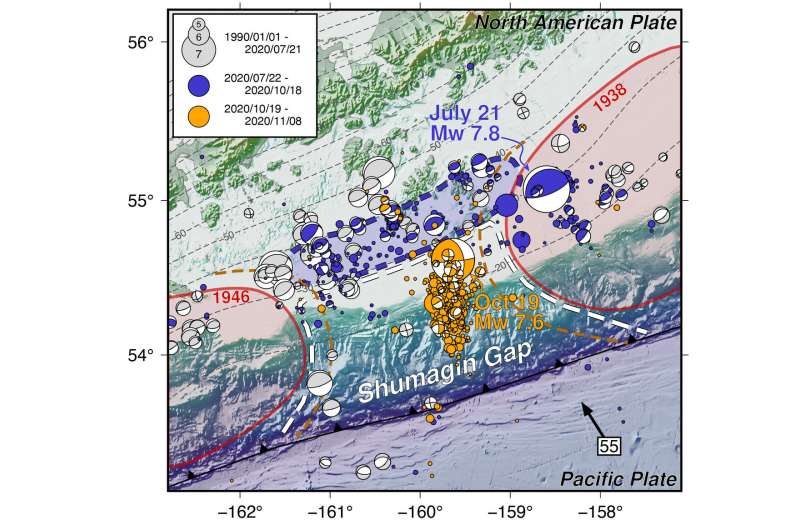Weird earthquake reveals hidden mechanism

The wrong type of earthquake in an area where there should not have been an earthquake led researchers to uncover the cause for this unexpected strike-slip earthquake—where two pieces of crust slide past each other on a fault—in places where subduction zone earthquakes—one geologic plate slipping beneath another—are common.
"The first earthquake that occurred in the Shumagin Islands region of Alaska was the right type," said Kevin P. Furlong, professor of geoscience, Penn State. "The second one was a strike-slip earthquake and that made no sense. That was the part that got us thinking."
In subduction zones, where two tectonic plates meet, one plate slides beneath the other. If the plates slide smoothly, they are considered unlocked or uncoupled. If the plates hang-up on each other for a time until the forces overcome the friction holding them and then release, causing an earthquake, they are considered locked or coupled. Some portions of a subduction zone can be locked while other parts may be unlocked.
In 2020, a subduction zone interface earthquake, the type expected at a subduction zone, occurred on the Alaska-Aleutian subduction zone to the east of an area called the Shumagin Gap. This first earthquake happened where other, similar earthquakes occurred in the past.
The Shumagin Gap is an area of the subduction zone considered to be unlocked and where geoscientists assume no earthquakes will occur. However, where the first earthquake occurred, just on the edge of the Shumagin Gap, the subduction zone is locked, and earthquakes have occurred there.
In October 2020, a strike-slip earthquake occurred in the Pacific Plate right in the middle of the gap, which was unexpected.
"There must be a fault in the subducting Pacific Plate, and we can't see it," said Furlong.
He explained that in the oceanic crust there are strike-slip faults that develop at the mid-oceanic ridges. This fault in the Shumagin Gap could be a relic of a fault from the mid-ocean ridge, activated in a different way. It appears to be in the correct direction, Furlong added.
To investigate this event, Furlong and Matthew Herman, assistant professor of geology, California State University, Bakersfield, modeled the earthquakes. They also included data from the small tsunami that occurred from the second earthquake. They found that, with the presence of a fault in the subducting plate, the uncoupled nature of the Shumagin Gap made an earthquake there more likely than if the area was coupled. The researchers report their result today in Science Advances.
"The potential for unusual earthquakes in these regions makes sense from our computational models," said Herman. "But it is still pretty counterintuitive that making the expected kind of earthquakes less likely actually makes other types of big earthquakes more likely."
The researchers found that tsunami data was helpful, especially in areas where GPS data were not available. Tsunamis also allow paleoseismologists to look at past events through any deposits left by previous earthquakes. Previously there was no evidence of large earthquakes in this area from tsunami data.
"There are probably other areas that are uncoupled where we assume they are safe from earthquakes, but they aren't," said Furlong. "They are unlikely to have a big subduction earthquake, but they could have a strike-slip earthquake. If there are people in the area, it could do damage with shaking and a small tsunami."
Furlong suggested there is an increased recognition that there are other ways of generating earthquakes on plate boundaries, and that we need to be a little more forward-thinking when we consider earthquakes on these boundaries.
More information: "Triggering an unexpected earthquake in an uncoupled subduction zone" Science Advances (2021). advances.sciencemag.org/lookup … .1126/sciadv.abf7590
Journal information: Science Advances
Provided by Pennsylvania State University



















